Glasses-free 3D: sideshow or solution?
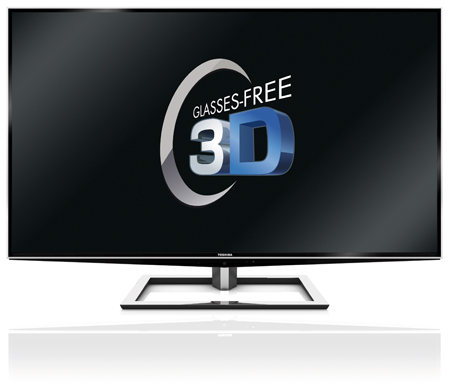
Can glasses-free 3D TV succeed where existing technologies have struggled? Indeed, will TVs able to deliver stereoscopic images without eyewear take off as viable consumer products, or are they destined to remain as attention-grabbing premium-priced products?
Well, we now have in our test rooms the Toshiba 55ZL2, the first commercially-available no-glasses 3D TV to arrive in the UK.
You can watch our unboxing video below, and we'll be publishing our full review and verdict here on whathifi.com on Monday, April 2nd, but ahead of that it's worth taking the temperature of the whole 3D TV thing, and trying to work out whether the Toshiba is simply a gimmick, or a signpost to the future.
Certainly something needs to be done – 3D TV hasn’t exactly wowed the buying public, and the jury's still out on whether it will be ‘the next big thing’ in consumer electronics.
Yes, sales of 3D TVs continue to rise, but that’s more by default – most medium- to large-screen TVs are now 3D-capable, regardless of whether buyers are choosing them for that capability, or indeed using it when they get the sets home.
Active glasses? Passive glasses? Or no glasses at all?
However, one of the biggest barriers to 3D TV viewing is the need to wear 3D glasses, not helped by the continuing claim and counterclaim of those companies supporting active-shutter glasses and those promoting passive 3D technology.
Get the What Hi-Fi? Newsletter
The latest hi-fi, home cinema and tech news, reviews, buying advice and deals, direct to your inbox.
So if choosing a glasses technology, not to mention wearing the glasses while watching, is the problem, is glasses-free 3D the solution?
Some – clearly including Toshiba – think it may be, but it wasn’t long ago (this time last year, to be precise) that Samsung poured cold water on the whole concept of no-glasses 3D, saying it was unlikely it would produce such a set in the next ten years.
“Attempts to put glasses-free 3D TV to market within the next 10 years will be difficult,” it said.
Sony is also non-commital, saying only "while research and development for glasses-less 3D TV for consumers is ongoing, we believe the best 3D viewing exerience for consumers at this stage is to enjoy and appreciate the high picture quality of 3D content using 3D glasses".
And LG believes glasses-free 3D TVs at a realistic price are "still a few years away". George Meade. LG UK's head of consumer marketing: home entertainment, says: "LG certainly believes that glasses-free 3D is the next logical step for this technology and we’re working toward that end.
"However, we’re still a few years away from introducing a large-screen TV that can display quality 3D without glasses at a realistic price point. We’ve been successful introducing glasses-free 3D in smartphones and PC monitors but the technology is not yet where we’d like it to be for multiple viewers to get the best experience without glasses.
"Until the technology and cost are at a level we’d like it to be, LG will continue to focus on creating the best viewing experience with our Cinema 3D range, which use comfortable and lightweight glasses that don’t need to be charged."
Certainly Toshiba stole a march on its rivals by announcing at IFA in Berlin last September that it would launch the world’s first, large-screen (55in), glasses-free 3D telly in time for Christmas. Now it's here – well, not quite in time for Christmas! – and that's the set we're testing now, and the one you can read about on Monday.

Glasses-free 3D has been with us for a good while, and indeed the technology behind it – two images being shown at once, with a lens array over the screen to divert each image to the correct eye – has been used in novelty still-image applications for decades.
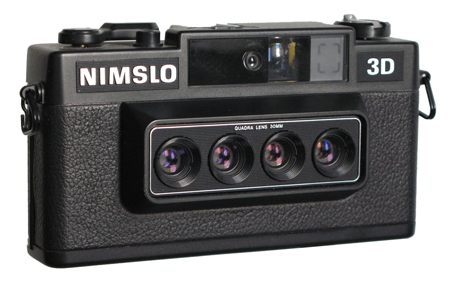
Back in the 1980s the ill-fated Nimslo camera (above), made at the Timex watch factory in Scotland by a company owned by shipping magnate Frederik Olsen, was heralded as the future of photography.
It wasn't the first camera of its kind, but it was the first point-and-shoot consumer model, taking four images of the scene on standard 35mm film – this was, of course, in the pre-digital age.
Pictures were printed with a lenticular layer over the images, allowing them to be viewed with the naked eye to give the 3D effect – again, not new, but Nimslo made the process simpler by automating it.
Trouble is, it was expensive, there were limited numbers of places able to do the special printing, and the pictures had an odd 'cardboard cut-out' quality to them. By the end of the 1980s, Nimslo was out of business.
The eyes follow you round the room...
Philips was among the first to apply the technology to displays a few years ago when the Dutch company started developing non-glasses 3D screens for use in advertising.
The idea was the product being advertised would appear in three dimensions as you walked past the screen in the street, at the station, airport or wherever.
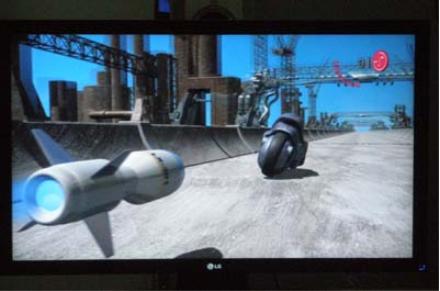
And back in 2008 Andrew Everard reported from Korea on LG's experiments with glasses-free TV technology (above), saying that the effect worked well enough – provided you stood or sat at a fixed distance, and didn't move!
Since then, the technology has moved from just TV screens to smaller devices such as the Nintendo 3DS (below) and LG’s Optimus smartphone.
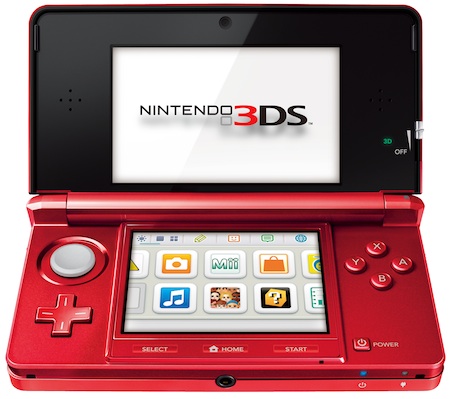
Gaming and cameras are an obvious market for adopting no-glasses 3D viewing, even though Nintendo felt the need to sound a note or two of caution to users of the 3DS.
"If you are tired, or feeling unwell, please refrain from playing. If you feel sick, please stop playing Nintendo 3DS immediately," it says.
Scary enough? No? Try this: "The use of the 3D feature by children aged six and under may cause vision damage.
"Therefore it is recommended that:
• Only children over six should use the system in 3D mode.
• If children aged six and under have access to the system, parents or legal guardians should restrict the display of 3D images using the Parental Controls feature."
Hmmm - perhaps not surprising that initial sales were slow, and it took a price-cut to get things moving. Mind you, though sales hit 15m units by the end of last year, the early sluggish take-up had a notable impact on the company's financial performance: it's predicting a loss of ¥65bn, or about £495m, for the financial year just about to end.
So, how does the technology work?
Glasses-free 3D displays use a 'parallax barrier' system, in which a filter in front of the display – essentially a series of lenses, like a fresnel design – ensures each eye sees different pixels, thus creating the 3D image. That's all well and good, but even slight movements of the head or viewing position can cause the image to collapse into 2D, or just a blur.
That's why no-glasses 3D is much simpler to do with smaller displays such as handheld games systems and mobile phones: the eyes are much closer to the display, and the head doesn't move much relative to the display while viewing.
It's when you scale up the screen, and increase the viewing distances and the number of viewers, that things start to get a bit tricky. A higher-tech solution is required to keep the 3D images stable, which is what we're now beginning to see in the bigger 3D screens now causing the most excitement.
Last July LG unveiled the world’s first ‘no-glasses’ Cinema 3D monitor', the 20in DX 2000 (below), selling for about £760 in Korea.
It offers a solution to one of the major problems of such designs by using innovative eye-tracking technology to ensure the right pictures are sent to each 'channel'.
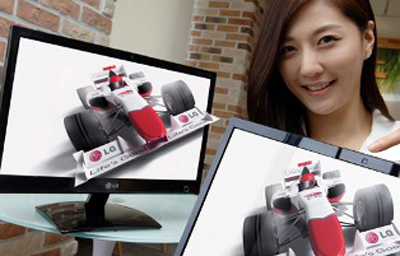
LG's technology, which it describes as 'naked eye 3D' uses a webcam-style device built into the display to track the position of the eyes, thus ensuring the correct images are sent to each eye by adjusting the angle and distance of the 3D image.
The company says it was the first to combine eye-tracking and parallax barrier technologies, and free viewers to move to different angles and positions without losing the 3D image.
The display also has a 3D switch function to convert 2D movies, pictures and games.
Not to be outdone, Toshiba followed up later in the year with its 55ZL2. This allows up to nine viewers to watch in 3D simultaneously without glasses, also using built-in face-tracking, combined with the firm's proprietary CEVO engine.
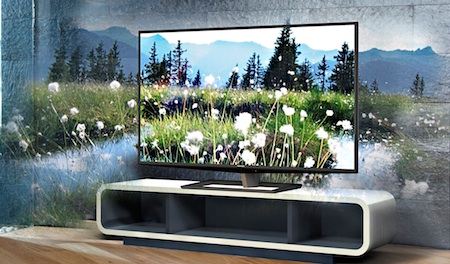
Using an array of lenticular lenses – said to be a first in such a large screen – Toshiba's engineers say they have been able to calculate multiple viewing points from stereoscopic images.
The glasses-free 3D technology is based on the stereoscopic principle of simultaneously delivering a picture for the left eye and another one with a small offset for the right eye, which are then 'superimposed' in the viewer's brain to create the 3D effect.
The set also displays 2D content in four times (Quad) Full HD resolution of 3840 x 2160 pixels.
That’s impressive, although such cutting-edge technology doesn’t come cheap – you’re talking £7000 in the UK, and initially you’ll only be able to buy the set in John Lewis’s Oxford Street branch or Harrods. Don’t expect to find it in your local Comet.
Initial impressions from our review sample are that the 3D effects are more subtle than those produced on sets requiring glasses, and as a viewing experience it’s more comfortable.
But you do have to sit very, very still as you watch – if move about, you’ll break the connection with the TV’s face-tracking system and lose the 3D effect. So you need to sit in exactly the same spot while viewing.
You’ll have to wait for our extended, official review on Monday to get our full verdict, but for now it looks as if glasses-free 3D will remain the preserve of the wealthy.
Andy is Global Brand Director of What Hi-Fi? and has been a technology journalist for 30 years. During that time he has covered everything from VHS and Betamax, MiniDisc and DCC to CDi, Laserdisc and 3D TV, and any number of other formats that have come and gone. He loves nothing better than a good old format war. Andy edited several hi-fi and home cinema magazines before relaunching whathifi.com in 2008 and helping turn it into the global success it is today. When not listening to music or watching TV, he spends far too much of his time reading about cars he can't afford to buy.

